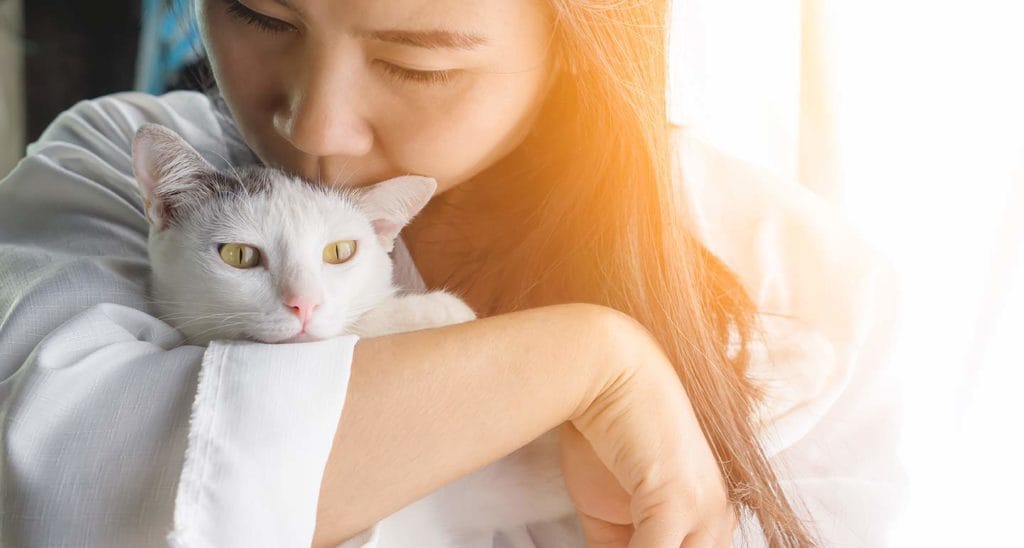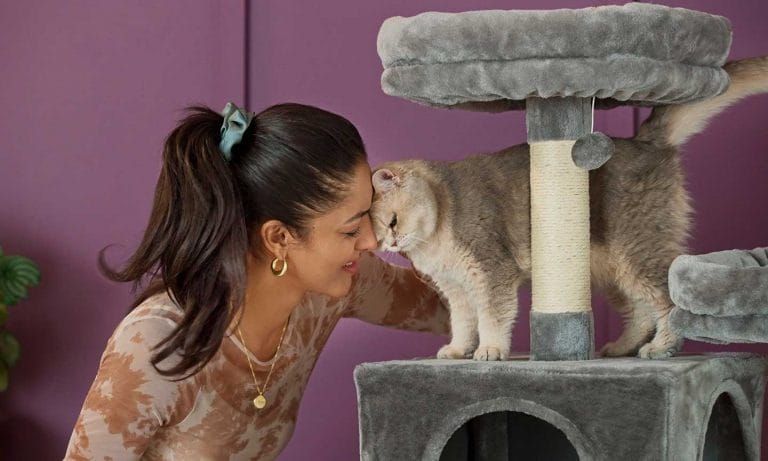Your bags are packed, your tickets are printed, and you reserved a spot for your pet at the best boarding facility in town. But despite being ready to go and knowing your pet is in the best possible hands, you still have a nagging feeling of anxiety about leaving your cat or dog behind while you head out on a fun trip.
Maybe it’s the first time you’re leaving your pet with a sitter overnight, or maybe you’ll be on two-week excursion—either way, you’re feeling bad about it. You wonder, ‘What if my pet thinks I abandoned him?’ and ‘She likes certain treats at certain times of day. Will this person know that?’
Could you actually have separation anxiety from leaving your dog or cat behind?
Fear not. We have expert tips for how to cope with the anxiety about leaving your cat or dog in someone else’s hands.
How to Prepare for Leaving Your Pets
Let’s say you’re planning a long overdue vacation, and you know you have to leave your beloved four-legged pal behind. What should you do to set you and your pet up for success?
Research Pet Sitters and Boarding Facilities in Advance
Before you book your plane tickets, search for well-qualified pet sitters or boarding facilities in your area.
“It’s natural for pet parents to feel anxiety about leaving their cat or dog in the care of someone else, and that is why using a professional pet sitter is so important,” says Beth Stultz-Hairston, vice president of marketing and operations for Pet Sitters International, a King, North Carolina-based educational association for professional pet sitters.
Be sure to look for professional pet-sitting businesses with credentials, such as pet-sitter insurance, a pet-sitting contract and proof of a background check, she adds.
After you’ve found several pet sitters or boarding facilities you like, schedule an in-person visit.
“I highly recommend doing a meeting ahead of time, because that really eases the pet parent a lot,” says Jessica Abernathy, president of the National Association of Professional Pet Sitters, a professional pet sitting organization based in Mt. Laurel Township, New Jersey.
She recommends actually interviewing the prospective caregivers.
“Prepare different questions for the sitter and explain what your expectations are," Abernathy says. "And just remember: You want a professional who’s screened, educated and certified.”
Melanie Lewis, a Phoenix-area pet sitter with Rover.com, an online-based network of professional pet sitters and dog walkers, says the first things she does with clients is give them a tour of her home, familiarize herself with them and their pets, and answer any questions they might have. It helps them feel comfortable before the stay even begins, she says.
“Relieving my pet owner’s anxiety about leaving their pet while traveling for work or going on vacation starts with our very first meeting,” says Lewis, who has 22 years of experience caring for people’s pets.
“I not only give the owner and their pet a tour of my home and property to show them exactly where their dog will be living, but I also take the time to chat with the owner about their pet to learn as much as I can about my guest dog’s lifestyle, habits, routine and preferences,” she continues.
Invest in a Good Pet Camera
If you will be leaving your pet at home and having someone stay with or visit your pet, a pet camera can help keep you connected. Some—like the Petcube Bites 2 Lite—even come with a treat dispenser, so you can show them some love even when you’re not at home.
Coping Emotionally with the Anxiety of Leaving a Pet
Let’s say you’ve done the pre-trip visits, but you’re still feeling guilt or nervousness about leaving your pet. What should you do?
Recognize That You Are a Good Pet Parent for Caring
First things first—remind yourself that feeling nervous actually means you are a good pet parent. You are concerned about the health and emotional well-being of your beloved pet.
“Emotions tell us something about our values. They tell us about what matters the most,” says Michelle Lopez, Ph.D., the assistant director of the Center for Stress and Anxiety Management in San Diego, California. “It’s kind of—in an odd way—a really good indication of the connection we have with our pet when we feel anxious or guilty. If we can remind ourselves, ‘OK, I’m feeling these things because of how connected I am and what this pet means to me,’ it can help us to cope more effectively.”
Lopez also wants pet parents to remember that leaving a pet with a trusted sitter or a reputable daycare is taking responsibility for that pet. Although you’ll be away from your dog or cat, you are still taking steps to keep your pet healthy, fed, loved and safe.
Do Deep Breathing Exercises
If anxiety about leaving your pet is still getting the better of you, Shannon Amabile, MFTI, of Silver Lake Psychology in Los Angeles, California, suggests deep breathing exercises.
“Take a moment and recognize the space you’re in, and that the anxiety is only a future worry,” Amabile says. With a breathing count of inhaling for four seconds, holding for four seconds and exhaling for four seconds, you are “creating this rhythm in the body and occupying the mind with counting,” which helps slow down racing thoughts, she says.
Create and Use Positive Affirmations
Affirmations are positive statements that can help you challenge the negative thoughts and view the situation differently.
Amabile recommends those that remind you of previous times in which you had to leave your pet (even if it was just a trip to the store) and how successful it was.
Tips for Making the Actual Separation Go Smoothly
The day of your trip has finally arrived, and you’re getting ready to drop your dog or cat at the kennel or the sitter. Follow these tips to ensure a smooth send-off.
Keep Calm Around Your Pet
One of the most important things you can do, even if you’re still having separation anxiety from leaving your dog or cat, is to avoid letting your pet sense your unease, says Kristen DeBlasio, owner and manager of the Dog Center at Faraway Farms in Providence, Rhode Island.
DeBlasio says that when you get nervous around your dog, “it transcends right through the leash to the dog. They sense, ‘My person is nervous, why are they nervous? Something bad must be going to happen.’”
The best thing you can do when you’re dropping your pet off is to be very matter-of-fact about the situation—even if your heart is racing and you feel guilty.
“Don’t do the, ‘Oh my god, goodbye, I’m going to miss you!’” DeBlasio says. “Make it routine—‘I’ll be back, see you later.’ Whatever you normally do when you leave them.”
She also recommends not bringing your dog’s favorite toys, blankets or dog beds from home as they might then spend a lot of their time “resource guarding,” meaning rather than getting used to their surroundings or engaging, they’ll protect their things from other dogs or pets in the home or boarding facility.
Stay Focused on the Fun That Awaits
Another thing to keep in mind when your emotions take over is that dogs, by nature, are pack animals who live in the moment, DeBlasio says. They’ll miss you, but they might actually have fun with their new friends and learn valuable socialization skills in the process, too.
After you and your pet have parted ways, it’s important to enjoy your trip and your time away. This is something for you, Lopez notes, and that’s important to keep in mind. If you rest and relax and have fun, you’ll come back an even better pet parent than the one you were when you left.
“It’s really important to take care of yourself, and it also helps to reduce the risk or possibility of resenting the animal if you’re thinking, ‘I can’t ever leave them,'” she adds.
Checking In—Without Feeding Your Anxiety
If you’ve chosen a facility that does photo updates or has a webcam, or if you set up a pet camera at your home, it’s best to proceed with boundaries. The same goes for checking in with your pet sitter, Amabile says.
“Reaching out and checking in on [your pet] is more of a quick fix for the anxiety, but it doesn’t actually help you relax,” she says. “Once you’ve checked in, it opens up the possibility of checking in two or three more times—and then you’ve stopped helping yourself.”
Lopez suggests coming up with a plan that works for both parties. For instance, rather than obsessively checking in, have a set plan to check in once in the morning and once before bed. By doing this, you are allowing yourself to enjoy your trip, while also feeling like the already-responsible parent you are.
For her clients, Lewis sends digital updates—including pictures—several times a day via Rover.com’s app.
“This gives them peace of mind and brightens their day with some cute pet snapshots,” she says. “Some pet parents are more engaged than others, wanting detailed daily updates versus some who only want a quick check in. I modify my updates to fit the pet owner’s individual needs.”
Some pet parents, says Abenathy, like handwritten check-in journals, some prefer weekly texts or emails, some appreciate the “report card” pet-sitting software that automatically sends updates, and still other want daily videos to see their pets in action.
“I had one client who had me record his cat every day meowing for him,” she says with a laugh. “He was gone for three weeks … But we’re happy to do those special requests for our clients.”
Tailoring each client’s communication plan is the method Stultz-Hairston recommends, too.
“While the pet parent is away, the pet sitter can cater the communication based on the pet parent’s preference,” she says. “Pet sitters typically leave daily notes at the home, but they can also send daily updates and photos or updates and photos after each visit. Whether a client wants to Facetime or prefers a text or email, the pet sitter can cater the communication to meet the pet parent’s request.”
As Lopez points out, it’s all about finding a healthy balance and learning that leaving your pet—and all the anxiety that goes along with it—is completely normal.
“It’s not unhealthy to be separated [from your pet] and it’s not unhealthy to feel anxious,” she says.
Expert input provided by Beth Stultz-Hairston, vice president of marketing and operations for Pet Sitters International; Jessica Abernathy, president of the National Association of Professional Pet Sitters; Melanie Lewis, a Phoenix-area pet sitter with Rover.com; Michelle Lopez, Ph.D., the assistant director of the Center for Stress and Anxiety Management; Shannon Amabile, MFTI, of Silver Lake Psychology; and Kristen DeBlasio, owner and manager of the Dog Center at Faraway Farms.
Learn more about separation anxiety in pets:
Share:












